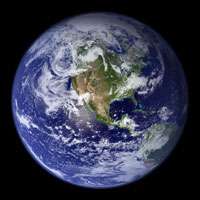Nearly half of the Earth's heat comes from the radioactive decay of materials inside, according to a large international research collaboration that includes a Kansas State University physicist.
Glenn Horton-Smith, associate professor of physics, was part of a team gathering some of the most precise measurements of the Earth's radioactivity to date by observing the activity of subatomic particles -- particularly uranium, thorium and potassium. Their work appears in the July issue of Nature Geoscience in the article "Partial radiogenic heat model for Earth revealed by geoneutrino measurements."
"It is a high enough precision measurement that we can make a good estimate of the total amount of heat being produced by these fissions going on in naturally occurring uranium and thorium," Horton-Smith said.
Itaru Shimizu of Tohoku University in Sendai, Japan, and collaborating physicists, including Horton-Smith, made the measurement using the KamLAND neutrino detector in Japan. KamLAND, short for Kamioka Liquid-Scintillator Antineutrino Detector, is an experiment at the Kamioka Observatory, an underground neutrino observatory in Toyama, Japan. Neutrinos are neutral elementary particles that come from nuclear reactions or radioactive decay. Because of their small size, large detectors are needed to capture and measure them.
Horton-Smith was involved with developing the KamLAND detector from 1998 to 2000 and he helped prepare it to begin taking data in 2002. Several years later, he was involved in an upgrade of the detector to help it detect solar neutrinos. For the most recent project, Horton-Smith's role was to help keep the detector running and taking measurements from nuclear reactors in Japan.
By gathering measurements of radioactive decay, the KamLAND researchers were able to observe geoneutrinos, or neutrinos from a geological source. They gathered data from 2002 to 2009 and had published their preliminary findings in Nature in 2005.
"That was the first time that observation of excess antineutrinos and a neutrino experiment were attributed to geoneutrinos," Horton-Smith said.
Previous research has shown that Earth's total heat output is about 44 terawatts, or 44 trillion watts. The KamLAND researchers found roughly half of that -- 29 terawatts -- comes from radioactive decay of uranium, thorium and other materials, meaning that about 50 percent of the earth's heat comes from geoneutrinos.
The researchers estimate that the other half of the earth's heat comes from primordial sources left over when the earth formed and from other sources of heat. Earth's heat is the cause behind plate movement, magnetic fields, volcanoes and seafloor spreading.
"These results helps geologists understand a model for the earth's interior," Horton-Smith said. "Understanding the earth's heat source and where it is being produced affects models for the earth's magnetic field, too."
The research also provides better insight for instances when materials within the earth undergo natural nuclear reactions. Based on their research, the physicists placed a five-terawatt limit on the heat cause by such reactions, meaning that if there is any geological heating from nuclear reactors in the Earth's core it is quite small when compared to heat from ordinary radioactive decay.
Provided by Kansas State University




















